
views
X
Research source
Since then, they’ve become an indispensable tool that helps many blind or visually impaired people navigate the world. We’ll show you how to hold and walk with your white cane to get you started, then show you how to navigate some common obstacles. We’ll also help you select a cane that’s right for you, so you can get up and out there!
- Hold your white cane in your dominant hand with your thumb resting on top of the grip and your forefinger pointing down the side.
- Sweep your cane with the “constant contact” method by dragging it lightly along the ground. Sweep it left and step with your right foot, and vice versa.
- Sweep with the “two-tap” method by tapping the cane at either side of the sweep, and hovering it just above the ground in between.
Holding and Walking with a Cane

Grip your cane in the palm of your dominant hand. Hold your dominant hand palm-up and place the grip of the cane diagonally across your palm, so that it extends out from the space between your forefinger and thumb. Then, wrap your fingers around the grip and rotate your hand so that your palm faces inward and your thumb rests on top of the grip. If you like, extend your index finger so that it points toward the tip of the cane. This can offer more maneuverability and tactile feedback. Hold your cane with a moderate grip. Too tight, and you may break the cane if it gets caught in something. Too loose, and it may get knocked out of your hand.
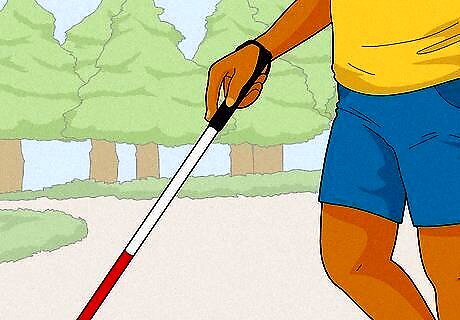
Hold your cane out like you’re giving a handshake. Rest the tip of the cane on the ground in front of you and position the base of the grip at about the same height as your belly button, centered in front of your torso. Hold it slightly away from your body, like you’re casually reaching out for a handshake. This is just a baseline grip; adjust your hand’s placement on the grip, how high you hold it, and how far away from your body you hold it to whatever’s comfortable for you. Holding your cane centered with your torso helps you get a better picture of what’s in front of you as you walk, without favoring one side. Holding your cane away from your body ensures that, if you bump into something, your cane doesn’t prod you in the stomach.

Sweep the cane back and forth with your wrist. Keeping your arm still, use your wrist to sweep the cane left to right and back again. Pretend there’s a boundary that extends from the outsides of your shoulders directly in front of you, and with each sweep, move the tip of the cane a couple inches outside that boundary. This helps you get a more complete idea of both what’s in front of you, as well as what’s slightly to the side. If you have wrist troubles, use your forearm to sweep the cane instead, pivoting your arm at the elbow.

Keep the tip of the cane on the ground as you sweep. Some cane users use the “constant contact” method, which is when you keep the cane on the ground at all times, dragging the tip lightly along the surface. This gives you a more continuous and complete idea of the terrain in front of you and helps reduce wrist strain, but may cause the cane to snag a bit more often.

Lift and tap the cane as you sweep for an alternate method. Others use the “two-point touch” method, in which you tap on either side of your cane’s sweep—left, right, left, right—keeping the tip of the cane just above the ground in between taps. This method reduces the number of times your tip snags on the ground and may enable you to walk faster, but takes a little more practice to use effectively.
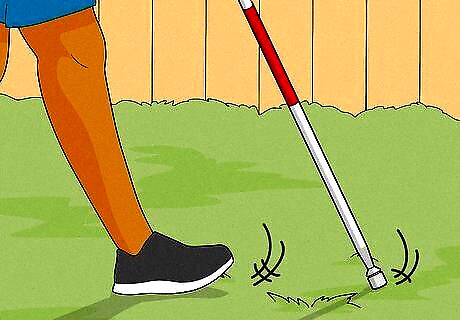
Walk one step forward for every sweep of your cane. As you move your cane to the right, step forward with your left foot. As you sweep the cane to the left, step with your right foot. This alternating pattern helps you avoid kicking the cane and establishes a smooth rhythm as you walk. It also helps you survey and clear the space in front of you before each step. Practice slowly at first. Sweep the cane, then take a step. Sweep, then step. As it becomes more comfortable, practice combining the motions together. Practice using the cane somewhere familiar, like in your home or at a nearby park, to help you get your bearings.
Navigating Common Obstacles

Use stairs by resting your cane on the next step in front of you. When you encounter stairs, slide your hand partway down your cane to effectively shorten it. Then, use the tip of the cane to determine how high and deep the steps are. To go up or down stairs, check the step immediately in front of you with the tip of your cane, then step onto it, and repeat this until the end of the stairs. Avoid sweeping your cane on stairs, since these are often fairly narrow and you may risk tripping another person.

Use the texture of the sidewalk’s edge to help you stay on track. When walking on a sidewalk (or any other linear path), align yourself to the side of the path so that your cane sweeps onto the grass or other adjacent textured surface at the edge of your sweep. This is called “shorelining,” and helps you to stay on the path as it straightens and curves along your route.

Note changing terrain when you encounter a series of bumps. As you’re walking through your city, you may encounter patches of raised ridges, bumps, or “dots” on the sidewalk. These tell you that there’s a sudden change in the terrain in front of you. It may be a curb, a road crossing, a different material of path, an incline, or any other change. When you encounter this texture with your cane, proceed with caution. Some cities use tactile ridges or lines on the sidewalk to indicate a bus stop. In this case, the lines lead to the edge of the curb, to the bus stop.
Choosing a Cane
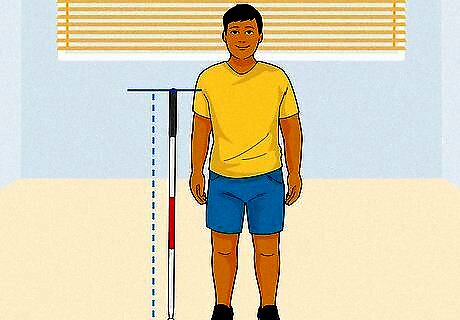
Choose a cane that’s about armpit-height. Many mobility instructors say to start with a cane that, when stood on-end, comes up to at least your armpit. This is generally a comfortable fit for beginners that allows for both maneuverability and reach. Many cane users prefer a cane that comes up to at least their nose, for added reach. If you can, try out multiple cane lengths and settle on one that’s easy to maneuver and not too heavy. Canes also come in a variety of materials—aluminum, fiberglass, wood, carbon fiber, and more. Each of these has a different weight, feel in your hand, and sound. Many canes are collapsible for easy carrying when not in use.
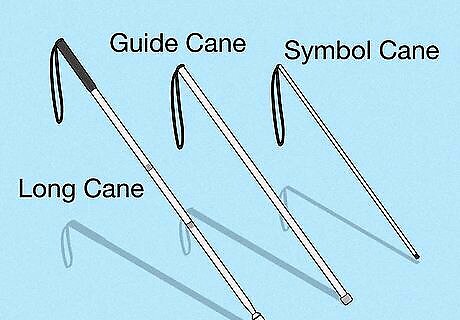
Select a long white cane for general use. “Long canes” are the traditional style of cane and are preferable for people with total vision loss. “Guide” canes are typically shorter and are ideal for people with partial vision loss, who can somewhat navigate their surroundings with the help of their vision. “Symbol” canes are very short and thin and are primarily used to communicate your partial vision loss to others instead of having to explain it verbally, as well as light navigation. These canes are also sometimes called “mobility canes,” “support canes,” and “identity canes,” respectively.

Pick the cane tip that best suits your usage style. Canes have a few different kinds of tips, many of which are detachable. The “pencil” tip is a simple, blunt point that’s ideal for two-tap navigating. “Marshmallow” tips are shaped like (you guessed it) marshmallows and roll back and forth along the ground, which makes them ideal for constant contact sweeping. Roller-ball tips are similar, but are a bit heavier than marshmallow tips. Ultimately, which tip you choose is totally up to you! Experiment with each and select the one that’s most comfortable.
















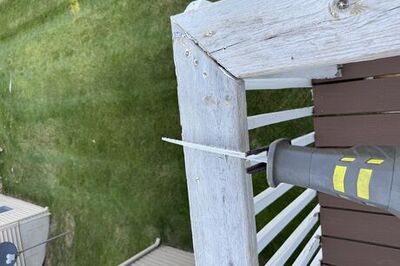


Comments
0 comment